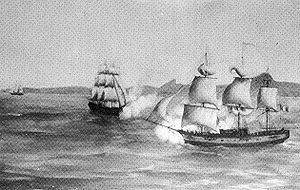
Antonio José de Sucre y Alcalá, known as the "Gran Mariscal de Ayacucho", was a Venezuelan general and politician who served as the president of Bolivia from 1825 to 1828. A close friend and associate of Simón Bolívar, he was one of the primary leaders of South America's struggle for independence from the Spanish Empire.
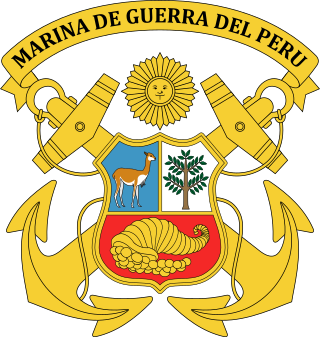
The Peruvian Navy is the branch of the Peruvian Armed Forces tasked with surveillance, patrol and defense on lakes, rivers and the Pacific Ocean up to 200 nautical miles from the Peruvian littoral. Additional missions include assistance in safeguarding internal security, conducting disaster relief operations and participating in international peacekeeping operations.
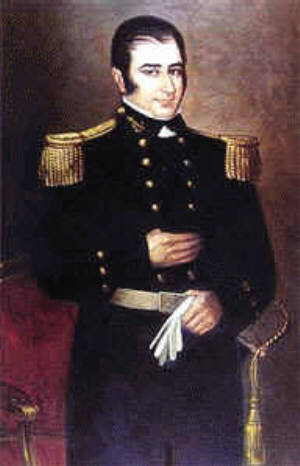
Hippolyte or Hipólito Bouchard, known in California as Pirata Buchar, was a French-born Argentine sailor and corsair (pirate) who fought for Argentina, Chile, and Peru.

The Battle of Angamos was a naval encounter of the War of the Pacific fought between the navies of Chile and Perú at Punta Angamos, on 8 October 1879. The battle was the culminating point of a naval campaign that lasted about five months in which the Chilean Navy had the sole mission of eliminating its Peruvian counterpart. In the struggle, two armored frigates, led by Commodore Galvarino Riveros Cárdenas and Navy Captain Juan José Latorre battered and later captured the Peruvian monitor Huáscar, under Rear Admiral Miguel Grau Seminario.

Miguel María Grau Seminario was a Peruvian Navy officer and politician best known for his actions during the War of the Pacific. He was nicknamed "Gentleman of the Seas" for his kind and chivalrous treatment of defeated enemies and is held in high esteem by both Peruvians and Chileans. Grau is an iconic figure for the Peruvian navy, and one of the most famous naval officers from the Americas.

The Ecuadorian Army is the land component of the Ecuadorian Armed Forces. Its 25,650 active soldiers are deployed in relation to its military doctrine. The contemporary Ecuadorian Army incorporates many jungle and special forces infantry units into its structure.

The Gran Colombian–Peruvian War of 1828 and 1829 was the first international conflict fought by the Republic of Peru, which had gained its independence from Spain in 1821, and Gran Colombia, that existed between 1819 and 1830.
Punta Malpelo is a point in Peru near the border with Ecuador. It was a significant scene during the Gran Colombia-Peru War, because on August 31, 1828, was the site of the Battle of Punta Malpelo, where the Peruvian corvette Libertad sustained a naval encounter with the Gran Colombian ships Pichincha and Guayaquileña with high casualties on both sides.
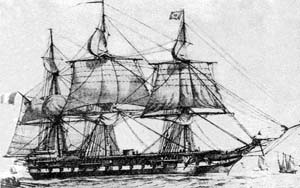
BAP Apurímac was the second steam frigate of the Peruvian Navy, built in England in 1855 along with the steam schooners Loa and Tumbes as a part of a major build-up of the Navy during the government of President José Rufino Echenique. A veteran of two wars and many internal conflicts, due to her age, she served as training ship in Callao port from 1873 until January 17, 1881, when she was scuttled along with the rest of the Peruvian Navy to prevent capture by Chilean troops who had occupied the port after the defeat of the Peruvian Army in the battles of San Juan and Miraflores.
The military history of Ecuador spans hundreds of years.
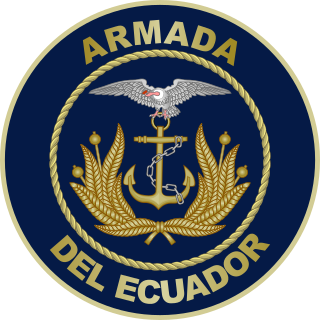
The Ecuadorian Navy is an Ecuadorian entity responsible for the surveillance and protection of national maritime territory and has a personnel of 9,400 men to protect a coastline of 2,237 km which reaches far into the Pacific Ocean. The vessels are identified by a ship prefix of B.A.E.: Buque de la Armada del Ecuador or L.A.E.: Lancha de la Armada del Ecuador.

The First Chilean Navy Squadron was the heterogeneous naval force that terminated Spanish colonial rule in the Pacific and protagonized the most important naval actions of in the Latin American wars of independence. The Chilean revolutionary government organized the squadron in order to carry the war to the Viceroyalty of Perú, then the center of Spanish power in South America, and thus secure the independence of Chile and Argentina.
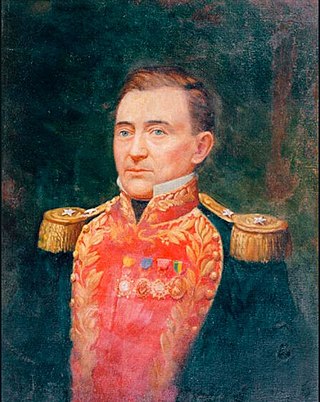
Thomas Charles Wright (1799–1868) was an Irish-born naval admiral. He was the founding-father of the Ecuadorian Navy, and a general in Simón Bolívar's army. He is regarded as a leading militarist in Ecuador's and other South American countries' struggle for independence.
Los Andes vs Prueba was a single ship action fought in 1820, during the development of the Spanish American Wars of Independence. The battle was between the corvette Los Andes and the frigate Prueba, the first a Chilean privateer and the second a ship of the Spanish Navy. It lasted two days and occurred in two different places. There are differences between Chilean and Spanish historiography on the exact date, the starting place, the development and the result of the naval action.
The Battle of Callao was a confrontation during the War of the Confederation, between the Chilean blockade of Callao under the command of Commander Bynnon and the Confederate privateer fleet under Jean Blanchet.
Agustín Manuel Hipólito Orella Macaya, known simply as Manuel Hipólito Orella, was a Chilean naval officer who made a career in the Chilean Navy. He was one of the first Chilean midshipmen who entered the nascent navy in 1818. He joined the First Chilean Navy Squadron and participated in the naval war for the independence of Chile and Peru. Likewise, also spent time in the Chilean Army in the infantry branch. Furthermore, he held several important positions in the navy until his death in 1857.

The 1828 Peruvian–Bolivian War, First Peruvian invasion of Bolivia or Frist Peruvian intervention in Bolivia was an invasion of Bolivia by Peru headed by Agustín Gamarra in the form of a foreign intervention in an internal conflict in the Republic of Bolivia, being the first important war in the new country, just three years after becoming independent, and endangering its autonomy as a result of the occupation. Its objective was to force the departure of the troops of the Republic of Colombia from Bolivia, the resignation of Antonio José de Sucre, and the prevention of the opening of a southern front in the event of a war with Colombia. The intervention escalated tensions further, culminating in the Gran Colombia–Peru War.

The third siege of Callao was a siege that took place in 1838 during the War of the Confederation between the United Restoration Army, supported by the Chilean army and the Peru–Bolivian Confederation. The confederates defeated the restorationist forces, who then retreated to Huacho due to the advance of the confederate army led by Andrés de Santa Cruz.

The battle of Cruces was a naval confrontation between the Peruvian and the Gran Colombian navy which occurred from 22 to 24 November 1828. The following blockade of the port of Guayaquil by the Peruvian Navy proved decisive in obtaining maritime dominance during the war and subsequently marked the end of the naval campaign between Peru and Gran-Colombia.

Antonio Ambrosio de la Haza Rodríguez was a Peruvian sailor. He was commanding general of the Navy (1878-1879).
